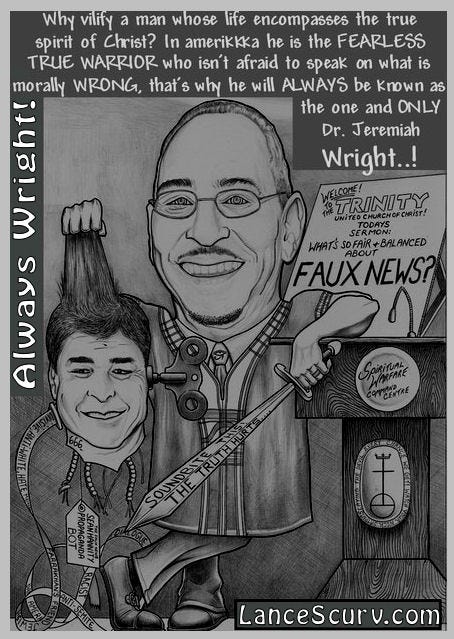REVEREND DR. JEREMIAH IS ALWAYS WRIGHT!
HE SHOWED US HOW TO STAND UP AGAINST FAKE NEWS
In 2008, during Barack Obama's presidential campaign, a significant controversy emerged involving his longtime pastor, Reverend Jeremiah Wright, and media personality Sean Hannity. This dispute became a focal point in political discourse, highlighting tensions between media representation and personal associations.
Background: Reverend Jeremiah Wright and Barack Obama
Reverend Jeremiah Wright served as the pastor of Trinity United Church of Christ in Chicago, where Barack Obama was a congregant for two decades. Wright officiated Obama's wedding and baptized his children, playing a pivotal role in his spiritual life. However, Wright's sermons often contained provocative statements about U.S. policies and societal issues, which later became points of contention.
The Controversy Unfolds
In March 2008, media outlets highlighted excerpts from Wright's sermons, where he criticized U.S. foreign policy and addressed systemic racism. One of the most cited remarks was his assertion that the U.S. government had brought on the 9/11 attacks due to its own actions.
Sean Hannity, a prominent Fox News commentator, seized upon these excerpts to question Obama's judgment and associations. Hannity expressed shock and anger, stating, "First of all, I will not let up on this issue. If his pastor went to Libya, Tripoli with Louis Farrakhan, a virulent, anti-Semitic racist, his church gave a lifetime achievement award to Louis Farrakhan. That's been Barack Obama's pastor for 20 years. And we will continue to expose this until somebody in the mainstream media has the courage to take this on."
Reverend Wright's Response
In response to the media scrutiny, Wright addressed his critics during a eulogy at a funeral, where he specifically mentioned Sean Hannity and Bill O'Reilly. He criticized their understanding of his sermons and perspectives, suggesting that they were misrepresenting his messages.
The Artistic Parody
The political illustration in question captures this intense media confrontation. In the artwork, Sean Hannity is depicted as a wind-up doll, symbolizing his repetitive dissemination of propaganda. His beheaded form, held by Reverend Wright, who wields a sword and leans on his pulpit with a smile, serves as a metaphorical representation of Wright's rebuttal to Hannity's attacks. The imagery underscores the perceived one-sidedness of the media narrative and Wright's resilience in the face of criticism.
Contextual Significance
This illustration reflects the heightened political tensions of the 2008 election cycle, where personal associations and media portrayals significantly influenced public perception. The controversy surrounding Wright and Hannity exemplifies the broader discourse on race, religion, and politics in America. The artwork serves as a satirical commentary on media sensationalism and the complexities of public figures' relationships.
By revisiting this episode, contemporary audiences can gain insight into the challenges faced by political candidates regarding their personal associations and the media's role in shaping public narratives. The illustration stands as a reminder of the enduring interplay between media representation and political discourse.



